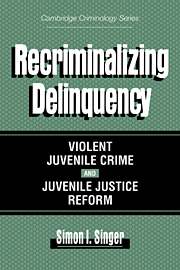Book contents
- Frontmatter
- Contents
- List of Figures and Tables
- Acknowledgments
- Introduction
- 1 Recriminalizing Violent Juvenile Crime
- 2 Taking Stock of Juvenile Justice Reforms
- 3 Recriminalization on the Move and Its Legal Rules
- 4 Contextual and Legal Reasons for Identifying Juveniles as Criminal Offenders
- 5 The Case Processing of Juvenile Offenders: From Arrest to Disposition
- 6 Recriminalization and Organizing for Deterrence
- 7 Convicted Juvenile Offenders in a Maximum Security Institution
- 8 Concluding “Real” Reasons for Recriminalizing Delinquency
- Appendixes
- Notes
- References
- Index
Introduction
Published online by Cambridge University Press: 29 September 2009
- Frontmatter
- Contents
- List of Figures and Tables
- Acknowledgments
- Introduction
- 1 Recriminalizing Violent Juvenile Crime
- 2 Taking Stock of Juvenile Justice Reforms
- 3 Recriminalization on the Move and Its Legal Rules
- 4 Contextual and Legal Reasons for Identifying Juveniles as Criminal Offenders
- 5 The Case Processing of Juvenile Offenders: From Arrest to Disposition
- 6 Recriminalization and Organizing for Deterrence
- 7 Convicted Juvenile Offenders in a Maximum Security Institution
- 8 Concluding “Real” Reasons for Recriminalizing Delinquency
- Appendixes
- Notes
- References
- Index
Summary
this is a case study of legislation that redefines previous acts of delinquency as crimes, and delinquents as juvenile offenders. It examines one state's response to violent juvenile crime through waiver legislation that transfers jurisdiction over juveniles from juvenile court to criminal court. Specifically, it focuses on the creation, implementation, and effects of New York's 1978 Juvenile Offender (JO) law, which lowered the eligible age of criminal responsibility to 13 for murder and 14 for other violent offenses.
The JO law is often referred to as waiver by offense categories or legislative waiver, and it is sometimes called automatic transfer legislation. It shifts the initial source of legal decision making on juveniles from juvenile justice officials to criminal justice officials. In contrast to more traditional systems of waiver that initiate with a hearing in juvenile court as mandated by the U.S. Supreme Court's 1966 Kent decision, legislative waiver begins with a specific set of offense categories for which juveniles can be considered criminally responsible.
In placing initial decision making in the hands of criminal justice officials, legislative waiver in New York and in other states “recriminalized” delinquency and juvenile justice. Like other newly created criminological words, such as deinstitutionalization or decarceration (Scull 1977), the word recriminalization has not yet entered the dictionary and is in need of a definition. I use it here to refer to the creation and implementation of legal rules that place juveniles in the adult criminal justice system.
- Type
- Chapter
- Information
- Recriminalizing DelinquencyViolent Juvenile Crime and Juvenile Justice Reform, pp. 1 - 4Publisher: Cambridge University PressPrint publication year: 1996
- 1
- Cited by

